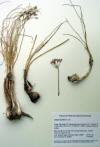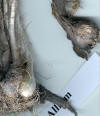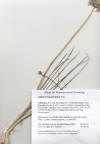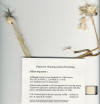|
Allium burlewii
|
|
  
Allium kunthii, Big Bend National Park,
|
|
|
Allium peninsulare
|
Allium triquetum
|
|
Allium drummondii Hartwell (1976), Kupchan reported activity due to a saponin. Devrim E. and I. Durak. 2007. Is garlic a promising food for benign prostatic hyperplasia and prostate cancer? Mol. Nutr. Food Res. 51(11):13191323. Prostate cancer is one of the most common male malignancies worldwide, and benign prostatic hyperplasia (BPH) is a common cause of lower urinary tract symptoms in elderly men. Garlic (Allium sativum) has been known to have anti-inflammatory, anti-cancer and antioxidant effects. Owing to these effects, garlic and its preparations have been used for the treatment of prostate cancer and relief of BPH symptoms for decades. It is thought that the mechanism(s) through which garlic may show anti-cancer and anti-inflammatory effects should be investigated further. Several researchers are attempting to demonstrate the useful properties of garlic and its mechanism(s) of action. This review aims to present the current studies related with the effects of garlic in prostate diseases, namely prostate cancer and BPH. Fani M. M., J. Kohanteb and M. Dayaghi. 2007. Inhibitory activity of garlic (Allium sativum) extract on multidrug-resistant Streptococcus mutans. J. Indian Soc. Pedod. Prev. Dent. 25(4):164168. Garlic ( Allium sativum ) extract has been known to have inhibitory activity on various pathogenic bacteria, viruses and fungi. The objective of present investigation was to study in vitro inhibitory activity of garlic extract on multidrug-resistant (MDR) strains of Streptococcus mutans isolated from human carious teeth. Filter sterilized aqueous extract of garlic was prepared and used in the present study. For isolation of S. mutans , extracted human carious teeth were cultured in Todd-Hewit broth and Mitis-Salivarius-Bacitracin agar. S. mutans was characterized by colony morphology, biochemical tests and other conventional bacteriological procedures. Disk sensitivity tests and broth dilution methods were used to determine antibiotic sensitivity profile and inhibitory activity of garlic extract on S. mutans isolated from carious teeth. Of 105 carious teeth tested, 92 (87.6%) isolates of S. mutans were recovered, among which 28 (30.4%) were MDR since they were resistant to four or more antibiotics. The highest rate of resistance was observed for tetracycline (30.4%) and least resistance (0%) to teichoplanin and vancomycin while 22.8% and 23.9% of the isolates were resistant to penicillin and amoxicillin, respectively. Chlorhexidine minimum inhibitory concentration (MIC) for MDR and non-MDR S. mutans varied from 2 to 16 microg ml-1 and from 0.25 to 1 microg ml-1 , respectively ( P S. mutans were sensitive to garlic extract with the MIC ranging from 4 to 32 mg ml-1 . Considering in vitro data obtained in the present study, mouthwashes or toothpaste containing optimum concentration of garlic extract could be used for prevention of dental caries. Park K.W., S. Y. Kim, I. Y. Jeong, M. W. Byun, K. H. Park, K. Yamada and K. I. Seo. 2007. Cytotoxic and antitumor activities of thiosulfinates from Allium tuberosum L. J. Agric. Food Chem. 55(19):79577961. In this study we isolated crude thiosulfinates from Allium tuberosum L. using CH 2Cl 2 and then with silica gel column chromatography purified S-methyl methanthiosulfinate and S-methyl 2-propene-1-thiosulfinate from the crude thiosulfinates. Subsequently, in vitro cytotoxicities against human cancer cells and in vivo antitumor activities of the thiosulfinates were investigated. Their cytotoxicities were strong in human cancer cells, in the order of S-methyl 2-propene-1-thiosulfinate, crude thiosulfinates, and S-methyl methanthiosulfinate. When thiosulfinates were administered consecutively for 7 days at 10, 30, and 50 mg/kg ip, in mice, we found significant increases in the life spans of mice that had been inoculated with Sacorma-180 tumor cells. The crude thiosulfinates also induced apoptosis in MCF-7 cancer cells. These results suggest that thiosulfinates from Allium tuberosum L. inhibit the proliferation of cancer cells via apoptosis and have antitumor activities. Slimestad R., T. Fossen and I. M. , Vεgen. 2007. Onions: A Source of Unique Dietary Flavonoids. J. Agric. Food Chem. 55(25):1006710080. Onion bulbs (Allium cepa L.) are among the richest sources of dietary flavonoids and contribute to a large extent to the overall intake of flavonoids. This review includes a compilation of the existing qualitative and quantitative information about flavonoids reported to occur in onion bulbs, including NMR spectroscopic evidence used for structural characterization. In addition, a summary is given to index onion cultivars according to their content of flavonoids measured as quercetin. Only compounds belonging to the flavonols, the anthocyanins, and the dihydroflavonols have been reported to occur in onion bulbs. Yellow onions contain 270-1187 mg of flavonols per kilogram of fresh weight (FW), whereas red onions contain 415-1917 mg of flavonols per kilogram of FW. Flavonols are the predominant pigments of onions. At least 25 different flavonols have been characterized, and quercetin derivatives are the most important ones in all onion cultivars. Their glycosyl moieties are almost exclusively glucose, which is mainly attached to the 4', 3, and/or 7-positions of the aglycones. Quercetin 4'-glucoside and quercetin 3,4'-diglucoside are in most cases reported as the main flavonols in recent literature. Analogous derivatives of kaempferol and isorhamnetin have been identified as minor pigments. Recent reports indicate that the outer dry layers of onion bulbs contain oligomeric structures of quercetin in addition to condensation products of quercetin and protocatechuic acid. The anthocyanins of red onions are mainly cyanidin glucosides acylated with malonic acid or nonacylated. Some of these pigments facilitate unique structural features like 4'-glycosylation and unusual substitution patterns of sugar moieties. Altogether at least 25 different anthocyanins have been reported from red onions, including two novel 5-carboxypyranocyanidin-derivatives. The quantitative content of anthocyanins in some red onion cultivars has been reported to be approximately 10% of the total flavonoid content or 39-240 mg kg (-1) FW. The dihydroflavonol taxifolin and its 3-, 7-, and 4'-glucosides have been identified in onions. Although the structural diversity of dihydroflavonols characterized from onions is restricted compared with the wide structural assortment of flavonols and anthocyanins identified, they may occur at high concentrations in some cultivars. From bulbs of the cultivar "Tropea", 5.9 mg of taxifolin 7-glucoside and 98.1 mg of taxifolin have been isolated per kilogram of FW. |
|




